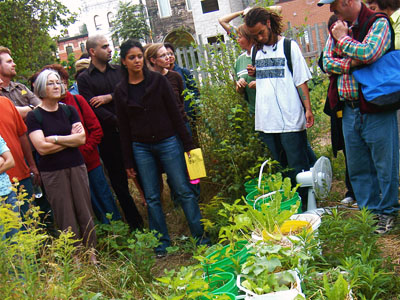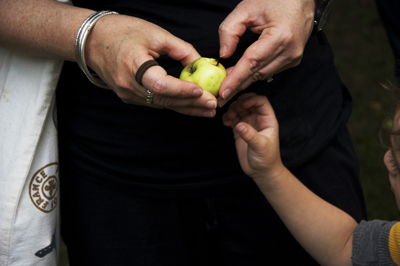Since 2006, LEAF has hosted over 80 of these tours in communities reaching from Chalkfarm to St. Jamestown, Unionville to Parkdale and all over Toronto and York Region. The guided walks focus on challenging the way citizens view their communities and empowering residents to take an active role in caring for their natural spaces. On a personal level, my first experiences with LEAF were photographing some of the early ones. After spending a few hours at it, I stopped speeding around the city and started paying attention to the trips as well as the destinations.
This was partly because tours have so much more to teach us than the shapes of leaves. They bring together diverse groups. They foster a healthy connection with nature. And according to studies out of Chicago by the University of Illinois and the American Planning Association, they can help build safer communities.

Parkdale Tree Tour, 2007
How so? Beyond the environmental benefits of getting outside, public green space is conducive to social gathering (think Trinity Bellwoods on a hot summer night). More people mean more eyes and so threatening behavior is more likely to be observed and is therefore avoided. And while that may seem pretty obvious, the Chicago report goes on to say “time spent in nature immediately adjacent to home helps people to relieve mental fatigue, reducing aggression.”
Tree tours encourage people to pay closer attention to the natural world around them. And newly found connections to our streets, parks and laneways, can spark healthy dialogue. When strangers get together to clean up a vacant lot, plant trees and shrubs, or set down a community garden, it builds social ties. They begin to better recognize the people next door as they come together around common goals -- something we saw with the Urban Forest Demonstration Gardens.

Parkdale Tree Tour, 2007
Each tour highlights the interesting features of an area as we explore themes from natural history to food security. Working in collaboration with other not-for-profits such as environmental organizations, BIAs, residents' associations and local historians we are able to paint a fuller picture of these areas. Bringing a positive focus onto these communities, we explore the features that shape the identity of our neighbourhoods.
Next Tuesday, Jessica Piskorowski will be working with the Toronto and Region Conservation Authority (TRCA) and the East Scarborough Storefront to explore the urban forest (and some of the biggest trees) around Highland Creek on the Morningside Park Tree Tour. The park holds two Environmentally Significant Areas (ESAs), an Area of Natural and Scientific Interest (ANSI), and a huge amount of biodiversity.
This is our second opportunity to work with the East Scarborough Storefront, an organization that works toward sustainable social innovation and transformation in communities. Local youth will highlight greening projects underway, including a green roof, eco food hub and better connections to the ravine. We can’t wait.
In the neighbourhood? You can sign up for the tour here.

Edible Tree Tour, 2011
Note: Enzo DiMatteo wrote a brief piece about the connection between trees and felonies in the July 5 issue of Now Magazine, which can be seen here.
